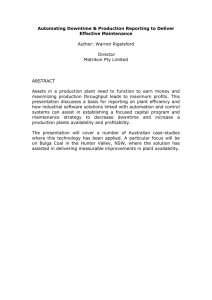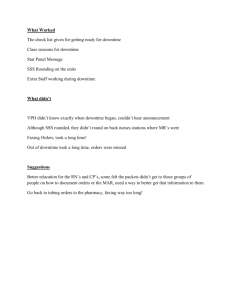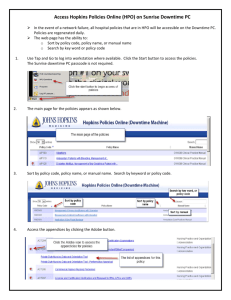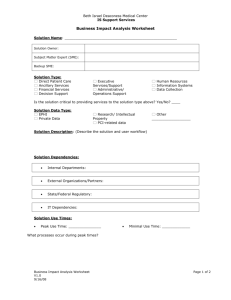MAINTENANCE DECISION MAKING MODEL USING
advertisement
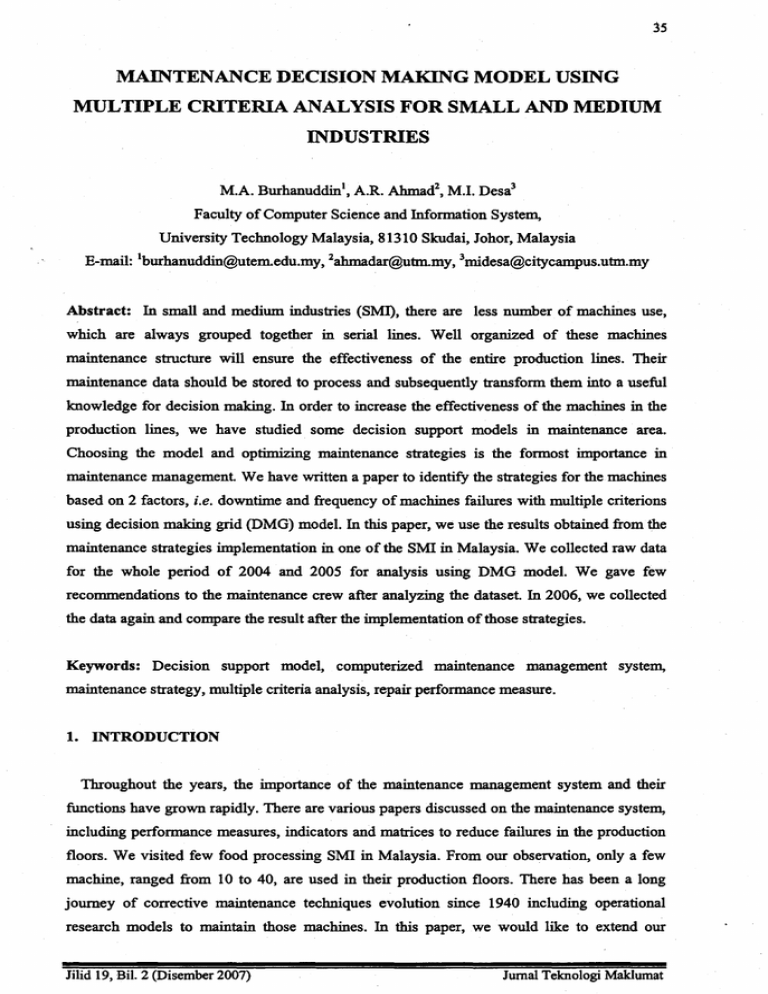
35
MAINTENANCE DECISION MAKING MODEL USING
MULTIPLE CRITERIA ANALYSIS FOR SMALL AND MEDIUM
INDUSTRIES
M.A. Burhanuddin1, A.R. Ahmad2, M.I. Desa3
Faculty of Computer Science and Information System,
University Technology Malaysia, 81310 Skudai, Johor, Malaysia
E-mail: Iburhanuddin@utem.edu.my.2ahmadar@utm.my.3midesa@citycampus.utm.my
Abstract: In small and medium industries (SMI), there are less number of machines use,
which are always grouped together in serial lines. Well organized of these machines
maintenance structure will ensure the effectiveness of the entire production lines. Their
maintenance data should be stored to process and subsequently transform them into a useful
knowledge for decision making. In order to increase the effectiveness of the machines in the
production lines, we have studied some decision support models in maintenance area.
Choosing the model and optimizing maintenance strategies is the formost importance in
maintenance management. We have written a paper to identify the strategies for the machines
based on 2 factors, i.e. downtime and frequency of machines failures with multiple criterions
using decision making grid (DMG) model. In this paper, we use the results obtained from the
maintenance strategies implementation in one of the SMI in Malaysia. We collected raw data
for the whole period of 2004 and 2005 for analysis using DMG model. We gave few
recommendations to the maintenance crew after analyzing the dataset. In 2006, we collected
the data again and compare the result after the implementation of those strategies.
Keywords: Decision support model, computerized maintenance management system,
maintenance strategy, multiple criteria analysis, repair performance measure.
1. INTRODUCTION
Throughout the years, the importance of the maintenance management system and their
functions have grown rapidly. There are various papers discussed on the maintenance system,
including performance measures, indicators and matrices to reduce failures in the production
floors. We visited few food processing SMI in Malaysia. From our observation, only a few
machine, ranged from 10 to 40, are used in their production floors. There has been a long
journey of corrective maintenance techniques evolution since 1940 including operational
research models to maintain those machines. In this paper, we would like to extend our
Jilid 19, Bil. 2 (Disember 2007)
Jurna! Teknologi Maldumat
36
fmdings after implementation of few maintenance strategies in the production floor, given by
[I]. Once the strategies are redefmed using Decision Making Grid model, then few rulesbased system can be derived to provide good decisions for maintenance department.
2. LITERATURE REVIEW
Small-scale industry is defmed as those with capital less than RM250,000.00 and having 5
to 49 workers [2]. Medium-scale industry employing 50 to 199 workers with capital
RM250,000.00 to one million. Companies beyond that limits are considered as a large-scale
industry. Since limited workers and capital used in SMI, there are only few machines installed
in SMI environment [2]. The downtime can be defmed as the total amount of time the
machines would normally. be out of service owing to the failure. It is the time from the
moment it fails until the moment it is fully repaired and re-operate again. Some repairing
activities will take place in between the unit's failure time and the time it is re-assembled. As
mentioned, equipment may experience breakdown at any time during their lifespan. They
may have multiple failures at a particular breakdown and which failures should be entertained
first is a concern. We have discovered that studying the failure data and the downtime by
itself is not enough to provide a decision for SM!. The machine may failed only once in two
years time, while others may fail more frequently, even with a shorter downtime.
There are still insufficient studies made on the application of measurement in service
processes as it always takes into consideration a verbal sense and are not to be dealt with
mathematically [3]. Output oriented management concept is used to evaluate some
maintenance performance indexes. By looking at the index, we can predict next failure and
prepare maintenance procedures accordingly. Systematic mathematical measurements on
covariates illustrated with the use of the semi-parametric, multistate hazards model for
transition and reverse transition among more than one transient state emerged from follow-up
studies [4][5]. The proportional-hazards model is used to analyze transitions in human
contraceptive use over time and illustrate the score test on testing the equality of parameters
for models on transitions and repeated transitions. Paper [6] employs the models proposed by
[5] to estimate the risk factors that delay the machines downtime. [6] identify the relationship
between repair time and various risk factors of interest including underlying characteristics of
the technicians, i.e. their age, experiences, qualifications and estimate them respectively.
Paper [7] analyze failure data, especially downtime using general renewal process for
repairable systems. [7] use Kijima Model II to model complex systems and'calculate general
likelihood function for single and multiple systems. Then they estimate the parameters with
the time truncated and failure truncated data using Weibull ++7. However, they used only one
parameter, failure data to be observed at a time.
Jilid 19, Bit 2 (Disember 2007)
Jumal Teknologi Maklumat
37
Paper [8] use fuzzy logic to derive rule-based decision support analysis. Later, [9] extend
the technique to assess and select most informative and efficient maintenance approach using
fuzzy multiple criteria decisi()n making evaluation methodology. [10] use a fuzzy linguistic
approach to achieve subjective assessments of maintenance strategies and practices in an
objective manner.
Paper [11] describe an application of analytic hierarchy process for selecting the best
maintenance strategy for an oil refmery. Then [12] proposed an artificial neural network
framework for repair time estimation after deploy the strategies. [13] reviews maintenance
organization models such as advanced terotechnological model, Eindhoven University of
technology model, total quality management, Total Productive Maintenance (TPM) and
Reliability Centered Maintenance (RCM) in their study. He concluded that maintenance can
be a contributor to profits by using Information Technology (IT) and showed that the
integrated IT as Computerized Maintenance Management System. (CMMS) permits coplanning ofproduction with maintenance.
CMMS provides good solution for data storage. However quantitative optimization
modules should be embed into CMMS to provide Decision Support System (DSS) to optimize
maintenance and close the gap between theory and practice. DMG considered as a
preliminary screening process model to identify potential machines for RCM, TPM etc. The
optimization strategy is not based only on the machines downtime, but also the frequency of
downtime, experienced by the individual machine to identify those critical machines. once
the most problematic machine is identified, further reliability analysis will be conducted to
improve their time-based maintenance. In particular, the maintenance management is able to: .
i)
Defme better maintenance strategy dynamically based on two factors, i.e. downtime
frequency and machine downtime simultaneously; and
ii)
Identify certain maintenance work knowledge that can be transferred from technical
experts to the operators in the production floor.
Paper [14] defmed DMG as a control chart by itself in 2 dimensional matrix forms. The
columns of the matrix· show the 3 criterion of the downtime, while the rows of the matrix
show 3 criterion of the frequencies of the failures. A better maintenance model for quality
management can be formed by handling both the rows and columns of the matrix
respectively. The matrix offers an opportunity to decide which maintenance strategies is
needed for decision making such as to practice fIXed-time maintenance, condition-based
maintenance or design-out maintenance. The grid can be used to decide which maintenance
concepts are useful for each defined cell of the matrix such as TPM or RCM approaches. The
results will provide maintenance policies in the respective functional group in production
lines to achieve their common goal to reduce downtime. We proposed some maintenance
Jilid 19, Bil. 2 (Disember 2007)
Jumal Teknologi Maklumat
38
analysis in this paper with few main objectives:
To enhance machine reliability analysis proposed by [14] to identify most
i)
problematic machine in the production floor;
ii)
To give few suggestion on the maintenance strategies for one of the food processing
8MI in West Malaysia; and
SMI
iii) Report some improvement after the implementation of those strategies.
3. MACInNES
MACHINES EFFICIENCY MEASUREMENT
Most of the reliability, availability and failures of the machines are dependent on time. [15]
represent the repetitive failure patterns as shown in Figure 1. Assume that N individual
machines placed in operation are up and running. The times at which failures, f, occur are
DJ be the total time that elapses
recorded during
d1Jring a test time interval, T. Let the downtime, TDJ
between the occurrence of the jth failure and the time the equipment back into normal
operation. Let NIf be the number of failures of the N device during the T interval.
Figure 1: Repairable Items Failure Patterns [15]
Based on Figure 1, few measures and formulae are derived as follows [15]:
Mean Downtime (MDT) =
1 J=N
J-N,f
LTD}
DJ
N fI }=1
j-I
-
LT
}=N,
NT- LTD}
Total Up time =
}=1
Mean Time Between Failures (MTBF)
Failure rate (A)
.
Jilid 19, Bil.
Bil2
2 (Disember
(Disernber 2007)
=
Nf
NT-NfMDT
Jumal Teknologi Maklumat
lumal
39
Availability ==
(NlxMTBF)
(NfxMTBF)
(N
xMTBF) + (Nf xMDD
(NIf xMTBF)+(NI
Unavailability =
=
(HI
(Nf xMDD
(NfI xMTBF)+(N
x MTBF) + (N xMDD
fI
The relationship between the concepts of reliability from MTBF, MDT, mean waiting time
(MTIR) are given in Figure 2. The machine is reliable when
(MWT) and mean time to repair (MTTR)
their MTBF is higher. As contrast, the lower is better for MDT.
A~uabkt~eforproduroon
Available time for production
....
/
MDT
/
/
,
....
Mean
Menn nme '
MTBF .... IfJespond Time.. ___ toRepilir ...
,
,
,
~
up
~
,
down
1
up
uIJ1
Figure 2: The relationship between MTBF, MDT, Mean Respond Time and MTIR
MTTR
As of our case study in the food processing company, we observed few main
characteristics, that machines must operate, given as follows:
i)
Reliability: they must work for at least 10 hours per day, 6 days a week in a year.
MTBF and MDT index is used as reliability measures;
Every machine have different frequency of failures. Once failed, it has different
ii)
downtime, which includes waiting and repairing time; and
iii)
Machines operate in a serial line to manufacture seven types of products in different
volumes.
In order to quantify both, time and costs of maintenance, various maintenance models were
introduced;
introduced: However, most of the mathematical methods, used to decide the inspection
intervals are too complicated to be resolved as 'ready to use' numerical solutions. Moreover,
in the practical applications, .the
the machinery plants must satisfy the required conditions of
these theoretical models; which are not the case usually. And yet, in this paper we proposed a
DMG model to derme maintenance strategy for the specific machine in theSMI
the 8MI production
plants.
4. DECISION MAKING GRID
We have fitted our data into multiple criteria analysis, introduced by [16]. We consider two
and machine downtime, separated in
major factors of failures, i.e. downtime frequency and.
Jilid 19, Bil. 2 (Disember 2(07)
2007)
Jumal Teknologi Maklumat
40
different criterion: high, medium and low. We developed a query to select top ten machines
having highest frequency of downtime. Subsequently, top ten machines have highest
downtime chosen from
aCMMS. The highest 3 is categorized as high. The next 3 is medium
and the last 4 as low. There are 3 stages in multiple criteria analysis [14]:
i)
Criteria Analysis: establish a Pareto analysis of the two factors, downtime frequency
and machine downtime,
ii) Decision Mapping: those machines that meet both criteria and rankedin step 1, are
mapped in the two dimensional matrix, and
iii) Once mapping is fmalized, the decision is developed by comparing the two
dimensional matrix developed in step 2 with Decision Making Grid (DMG) as
shown in Figure 3.
Frequency
Downtime
Low
Medium
High
Low
OTF
FTM
CBM
Medium
FTM
FTM
FTM
High
SLU
FTM
OOM
Figure 3: Decision Making Grid (Labib(2004»
The objectives of this exercise is to implement appropriate strategies that will lead to the
movement of machines towards an improved maintenance stages, complied with [14], respect
to the multiple criterion as follows:
i)
Operate to failure (OTF): Machine is very seldom failed. Once failed, the downtime
is short;
ii)
Fixed time maintenance (FTM): Failure frequency and downtime are almost at the
moderate cases;
iii) Skill levels upgrade (SLU): Machine is always failed, but it can be fixed very fast;
iv) Condition-based maintenance/ (CBM): Machine is very seldom to fail. But once
failed, it takes a long time to bring it back to the normal operation; and
v)
Design out maintenance (DOM): Machine is always failed. Once failed, it takes a
long time to bring it back to the normal operation.
TPM strategies is reconnnended for lower triangle of the DMG matrix as shown in Figure 4
[16].
TPM is applied widely in Japanese industries and one of the TPM concept is to
empower the operators to maintain continuous productions on totally efficient lines [17]. Our
approaches of TPM are the continuous knowledge transfer to operators and maintain the
production machines together with the maintenance crew. Hence, slowly we can reduce a
Jilid 19, Bit. 2 (Disember 2007)
Jumal Teknologi Maldumat
41
responding time for technicians to be in the production plant. Also, it gives the opportunities
to operators to eliminate the root causes of machines errors at the initial stage, before they
become big ones.
Frequency
Downtime
Low
I
Low
Medium
High
Medium
High
~::]
~: I
~::] ~
TIM
TPM
~.
Figure 4: DMG-TPM Strategy
RCM approach should be applied for upper triangle of the matrix as shown in Figure 5
[16]. RCM involved a study and measurement of the probability that a machine will operate
as expected as desired level, for a specific period of time under the design operating
conditions without any failures. Once those problematic machines are identified, maintenance
strategy is adjusted to ensure the longest survival of the machine to complete their production
mission at specific time [18]. Strategies
Strategies such as condition-based monitoring or design out
maintenance is executed based on the measurement and estimates.
Frequency
Downtime
Low
Low
Medium
High
Medium
High
I~Di~]
Figure 5: DMG-RCM SU'ategy
s. CASE STUDY
5.
As a case study, we choose a SMI in Malaysia, a food processing company, which proven
to have the capabilities to meet stringent customer requirement in terms of quality, price and
delivery schedule. We collected a real dataset of the machines failures for the whole period of
the year 2004 and 2005. Over the period, 109 breakdown were recorded. The operation time
zone is set from 8:00am to 6:00pm, 6 days a week. Currently, all maintenance activities are
recorded manually using forms. We proposed a CMMS, to be embedded with DMG for the
21· machines, that utilized to produce starfruit
staifruit
company. We consider all types of failures for 21
jam, rozel jam, pineapple jam, roselle cordial juice, seri kaya, kaya madu and ground fried
coconut. Out of21 machines, only 14 experienced failures over the year of2004
of 2004 and 2005.
Total production operating times for these 2 Yl.?nrs
years are
nre expected at 6240 hours. Machine
(ID), number of
efficiency analysis is shown in Table 1. The fields are the machine name (ill),
Jilid 19, 'Bi).
'Bit. 2 (Disember 2007)
Juma! Teknologi Maklumat
Maldumat
Jurnal
42
failures (Freq), breakdown time in hours (Downtime), mean downtime in hours (MDT), mean
time between failure in hours (MTBF), failure rate, ilvailability of the machine (Avail) and
unavailability of the machine (Unavail). Machine H (Filling machine), is experienced highest
number of failures (30 times) with longest downtime (737 hours), and followed by label
machine, M (19 times). Machine H shows the lowest MTBF (183 hours) and machine B
(coconut milk squeezer) shows the highest MDT (30 hours). This means that both machine H
and B are the most unreliable machines in the production floor. Machine A (coconut grinder)
is the most reliable machine as it has highest MTI3F (6238 hours) and lowest MDT (2 hours).
Table 1: Efficiency Measures of the Machines
ID
Freq
A
B
C
D
E
F
I
G
H
J
K
L
M
N
p
Total
3
8
2
5
16
5
30
5
3
1
19
9
2
109
Down
time
2
89
193
13
33
249
129
737
73
54
8
188
63
33
1864
MDT
MTI3F
failure Rate
Avail
Unavail
2
30
24
7
7
16
26
24
15
18
6238
2050
756
3113
1241
)74
1222
183
1233
2062
6232
318
0.0002
0.0005
u.0013
0.0003
0.0008
0.0027
0.0008
U.0055
0.0008
u.u005
11.0002
('u031
(; d015
".1'003
0.9997
0.9857
0.9690
0.9979
0.9947
0.9600
0.9792
0.8819
0.9882
0.9913
0.9987
0.9698
0.9898
0.9947
0.0003
0.0143
0.031
0.0021
0.0053
0.04
0.0208
0.1181
0.0118
0.0087
0.0013
0.0302
0.0102
0.0053
0
8
10
7
17
211
(i86
3103
28811
Based on the criterion analysis proposed by Lahb (2004), we have developed two
dimensional matrix for the machines on both the frequency and downtime factors as shown in
Figure 6.
Frequency
Low
M~i~
High
Downtime
I
Low
Medium
J, K
N
G,II
High
C
l\!
H, F
Figure 6: Maintenance matrix based on .: ')04 and 2005 Dataset
The maintenance matrix is evaluated thoroughly with DMG models in Figure 3, 4 and 5
above. Based on 2004 and 2005 DMG analysis in Figure 6, we recommend few maintenance
strategies or actions as follows:
i)
Machine J (Bottle washer and cleaner) and ~fachine K (Capping machine) fall in
matrix, DMG1,l at OTF's region. Since both frequency of breakdowns and downtime
are low, we recommend that the current mrtilltenance strategy should be maintained
Jilid 19, Bil. 2 (Disember 2007)
JumalTeknologi Maklumat
43
and strictly followed. However, TPM strategy can be considered on teaching the
operators to tight up the connectors. So that, they can adjust the connectors once
failures occurs at the initial stage.
ii)
Machine N (Cuplid machine) falls in matrix, DMG2,l at FTM's region. Since it is near
to the OTF's region, then who will perfonn the repair is the concern. The machine is
always failed but it is easier to fix the problem where time taken to repair is not very
long. If the maintenance crew can train the operators to adjust the belting, then the
downtime especially on technicians responding time can be reduced tremendously.
iii)
Machine G (Pump and piping for cookers) and Machine B (coconut milk squeezer)
fall in matrix, DMG 1,2 at FTM's region. Since it is near to the OTF region, it requires
re-addressing issues regarding when will the maintenance instruction to be
/
implemented. This is true with our observation where Machine G has a lot of problem
with the motor pump. Maintenance crew should re-evaluate their preventive
maintenance strategy on changing the engine oil. As of Machine B, most of the
problem occurs because of the coconut waste filter always tom. We suggest to keep
the filter as the inventory control item in the store and change it at least once in every
six months. Further analysis on delay time modeling introduced by [19] could help to
provide better preventive maintenance estimation for the machines, G and B.
iv)
Machine C (Coconut milk siever) fall in matrix, DMG2,3 and subsequently, Machine
M (Jetprinter and labels) falls in matrix, DMG3,2. Both fall in FTM's region. The
difficult issues in these two regions are the one related to the contents of the
instruction itself. It might be the case that the wrong problem is. being solved or the
right one is not being solved adequately. From our observation on machine M
failures, shows that most of the problem due to the usage of liquid type of ink to print
the labels in the production floor. The ink is incompletely injected by the printer head
and nozzel. We found that the problem is not being solved adequately, where
technicians just service and adjust the head and nozzel for most of the time. We
recommend that the maintenance crew should start looking at the type of ink is used.
Laser jet ink may improve the print out quality as it dry faster and reduce the particles
in the production lines.
v)
Machines H (Filling machine) and F (Cooker) fall in matrix, DMG3,3 at DOM's area.
Both machines· are identified as .the worst perfonning machines based on both
frequency and downtime criterion. Major design out projects need to be considered or
purchase backup machines as a redundancy plan. Or install predictive-maintenance
monitoring equipment, or fonn production emergency response team or trigger any
emergency indicators immediately in the production floor, when these machines fail.
Or embed these machines with self maintenance capability to reduce downtime as
Jilid 19, Bil. 2 (Disember 2007)
Jurnal Teknologi Maklumat
44
recommended by [20]. Consequently, we recommend that the maintenance engineers
to conduct thorough analysis on machines, H and F, which includes maintenance cost
analysis, RCM or analytic hierarchy process to count how much losses to the
production floor.
After giving the recommendation, we collected another set of data for the whole
period of 2006. The resulting DMG is shown in Figure 7.
Frequency
Low
Downtime
Low
Medium
H,B,N
G
Medium
High
A
High
E
M
Figure 7: Maintenance matrix based on 2006 Dataset
After implementation of those strategies based on Figure 6, there are some
improvement, especially for machine H, B and N as shown in Figure 7. We have reduced time
waiting for parts for machine B by keeping waste filter as an inventory control item, where B
is removed from DMG1,2 in Figure 6 to DMG1,I in Figure 7. We observed that the failure due
to the machine N is reduced, where N is removed from DMG2,I in Figure 6 to DMG1,I in
Figure 7. This is because of the technicians effort to provide proper training to operators on
simple repairing task such as adjusting the Cuplid machine's belt. There are not much
comments we can give on machine F as there is a backup cooker installed in the production
plant and operate as a standby unit whenever failure occurs on machine F. Similarly, new
filling machine is installed to replace worst performing machine, where H is improved from
DMG3,3 in Figure 6 toDMG1,I in Figure 7.
6. CONCLUSION
Small and medium industries in Malaysia startup with smaller capitals, hence they are not
able to upgrade the entire production lines as a whole. They always operate with limited
number of machines to produce a few types ~f products; The machines operate with their own
specific functions and always contribute to a dedicated mission in the production serial lines.
They operate with the minimum number of maintenance staff and sometime outsource the
maintenance work. As far as maintenance is concerned, they will just follow maintenance
guidelines provided by the machine's suppliers. They are still lack of good CMM:S in place
with decision making capabilities to measure the machines utilization based on their operation
Jilid 19, Bit. 2 (Disember 2007)
Jumal Teknologi Maldumat
45
time. We believed that they may either under or over maintain certain machines. in their
production floors. As mentioned earlier, based on the SMI nature of business, DMG model is
the most suitable to be embed with the CMMS to identify different strategies of the
maintenance based on their utilization.
The failure records of 21 machines are considered in our study for the whole years of 2004
and 2005. We have conducted DMG analysis in Figure 6 and identified machine J, K; M and
N .for TPM approach. If the maintenance management can train the operators to handle basic
troubleshooting of these machines, downtime of the machines can be reduced tremendously.
RCM approach should be implemented for machines, B, C, F, G and H. After the
implementation of the strategies, we observed that purchasing new machine H and cool
standby unit of machine F are able to reduce their downtime. Figure 7 shows some evidence
of the improvement after implementation of the strategies based on Figure 6 multiple criteria
analysis.
ACKNOWLEDGEMENT
The authors are greateful to the maintenance management of the food processing
companies to allow us for visiting and conduct the case studies.' Thanks to the Head Faculty
of Information and Communications Technology, Universiti Teknikal Malaysia Melaka for
providing facilities and support in the completion of this paper.
REFERENCES'
[1] Burhanuddin, M.A, Ahmad, A.R. and Desa, M.I, "An Application of Decision Making
Grid to Improve Maintenance Strategies in Small and Medium Industries", IEEE
International conference of Industrial and Electronics Applications, 2007.
[2] Ghani, M.K, "Rural-Based Food Processing Industry", Asian Productivity Organization
Report, Japan, 2004.
[3] Mustafa, G, "Reliability of service systems and an application in student office",
International Journal of Quality and Reliability Management, 2002.
[4] Cox, D.R. and Oakes, D, "Analysis of Survival Data", Chapman and Hall, New York,
1984.
[5] Islam, M.A, "Multistate Survival Models for Transitions and Reverse Transitions: an
Application to Contraceptive Use Data", Journal of the Royal Statistical Society A,
1994.
[6] Burhanuddin, M.A, "Reliability analysis of delay in repair time using hazards model",
Integrating Technology in the Mathematical Sciences Conference, 2003.
Jilid 19, Bil. 2 (Disember 2007)
Jumal Teknologi Maklumat
46
[7] Adamantios, M and Wenbia, Z, "Modeling and Analysis of Repairable Systems with
General Repair", IEEE Proceedings Annual Reliability and Maintainability Symposium,
2005.
[8] Triantaphyllou, E., Kovalerchuk, B., Mann, L.J. and Knapp, G.M, "Determining the
most important criteria in maintenance decision making", Journal of Quality in
Maintenance Engineering, 1997.
[9] AI-Najjar, B. and Alsyouf, I., "Selecting the most efficient maintenance approach using
fuzzy multiple criteria decision making", International Journal of Production Economics,
2003.
[10] Mechefske, C.K. and Wang, Z, "Using fuzzy linguistics to select optimum maintenance
and condition monitoring strategies", Mechanical Systems and Signal Processing, 2003.
[11] Bevilacqua, M. and Braglia, M., "The analytic hierarchy process applied to maintenance
strategy selection", Reliability Engineering and System Safety, 2000.
[12] Burhanuddin, M.A, Ahmad, A.R. and Desa, M.1, "Collective Approach for Repair time
Analysis", IEEE International conference on Industrial Infonnatics, 2006.
[13] Sherwin, D, "A review of overall models for maintenance management", Journal of
Quality in Maintenance Engineering, 2000.
[14] Labib, W.A, "A decision analysis model for maintenance policy selection using a
CMMS", Journal of Quality in Maintenance Engineering, 2004.
[15] Bentley, J.P, "An Introduction to Reliability and Quality Engineering", John Wiley'&
Sons Inc., 1993.
[16] Labib, W.A, "World-class maintenance using a computerized maintenance management
system", Journal of Quality in Maintenance Engineering, 1998.
[17] Nakajima, S, "TPM", Productivity Press, 1988.
[18] Elsayed, "Reliability Engineering", Addision Wesley, 1996.
[19] Christer, A.H, "Developments in delay time analysis for modeling plant maintenance".
Journal of the operational research society, Vol. 50, pp. 1120-1137.
[20] Labib, W.A, ''Next Generation Maintenance Systems: Towards the Design of a Selfmaintenance machine", IEEE International conference on Industrial Infonnatics, 2006.
Jilid 19, Bil. 2 (Disember 2007)
Jumal Teknologi Maklumat
